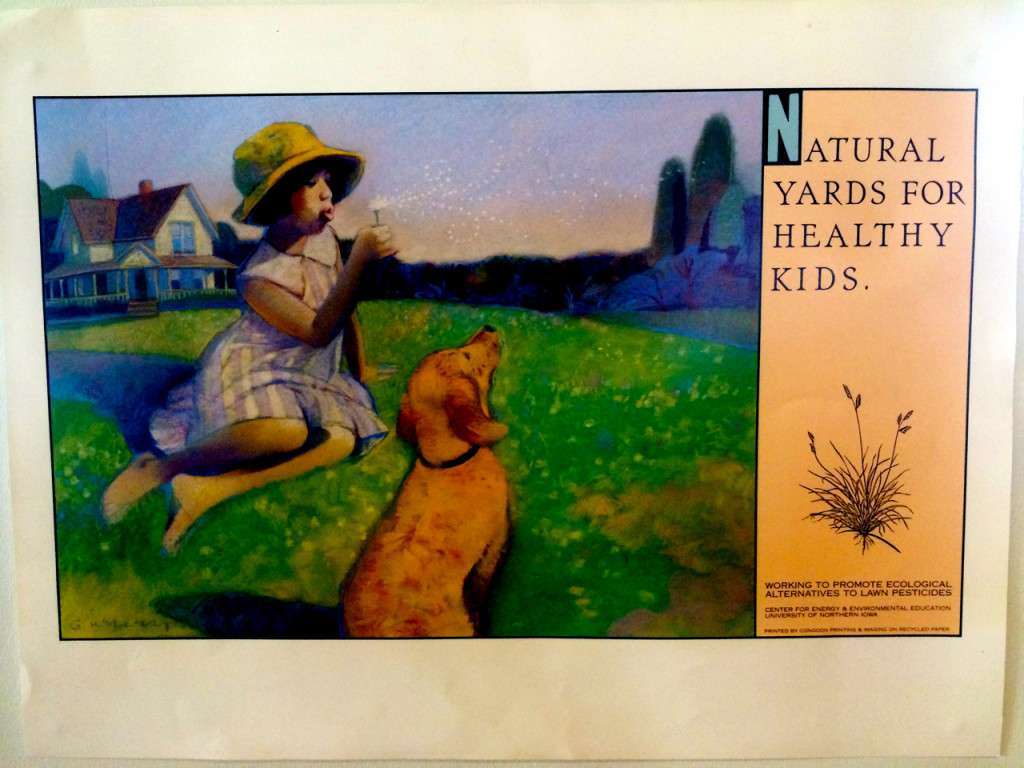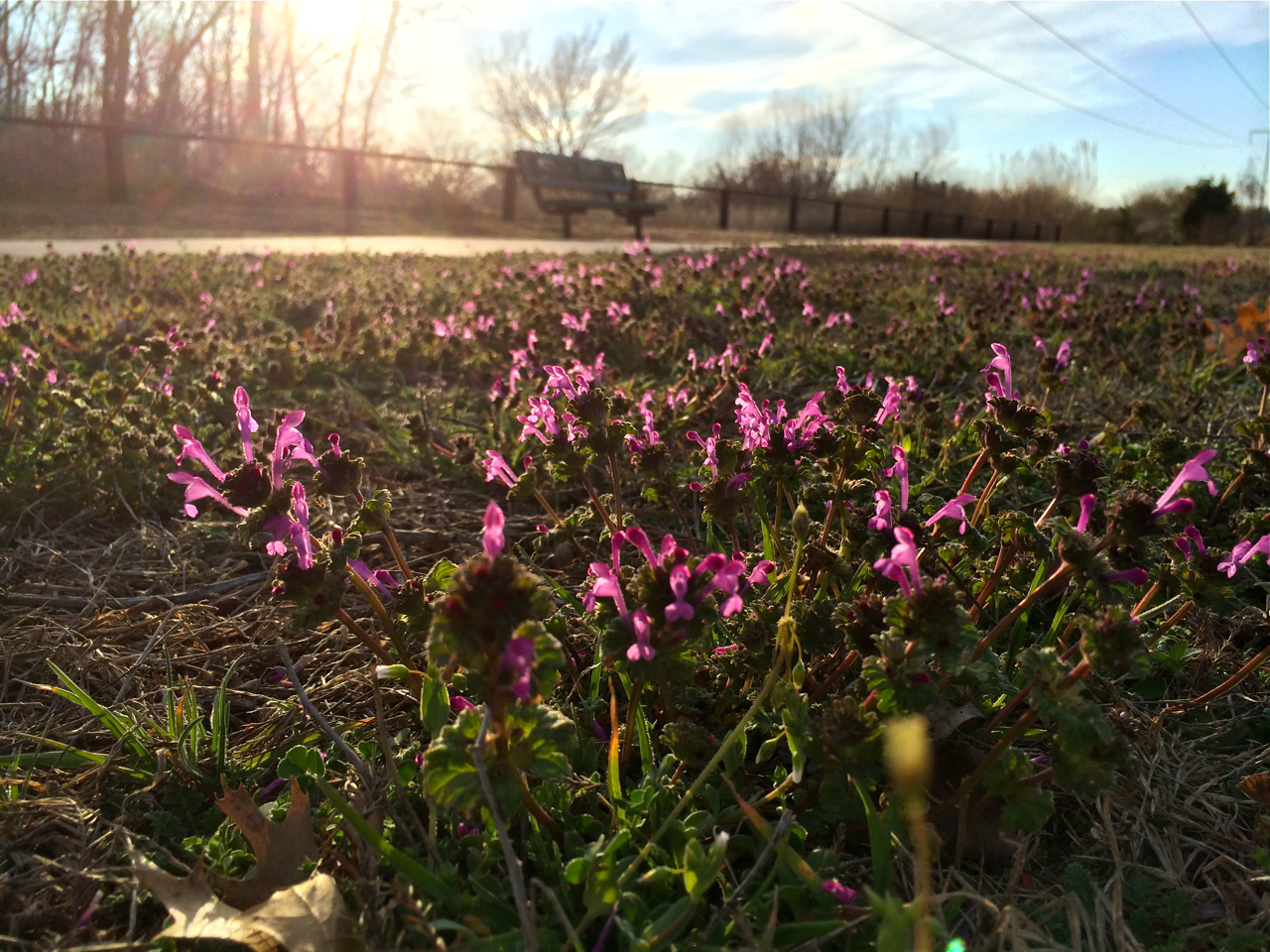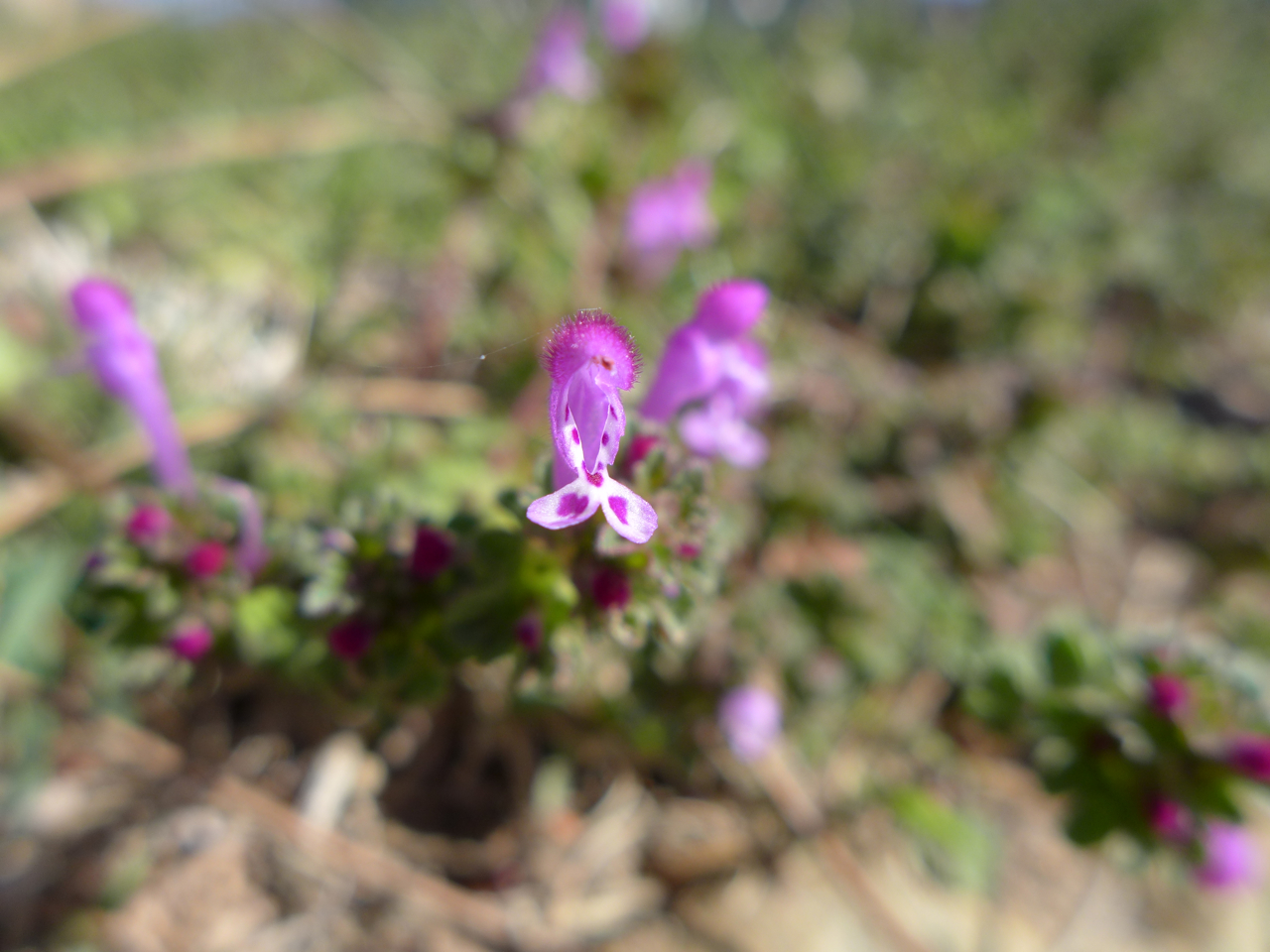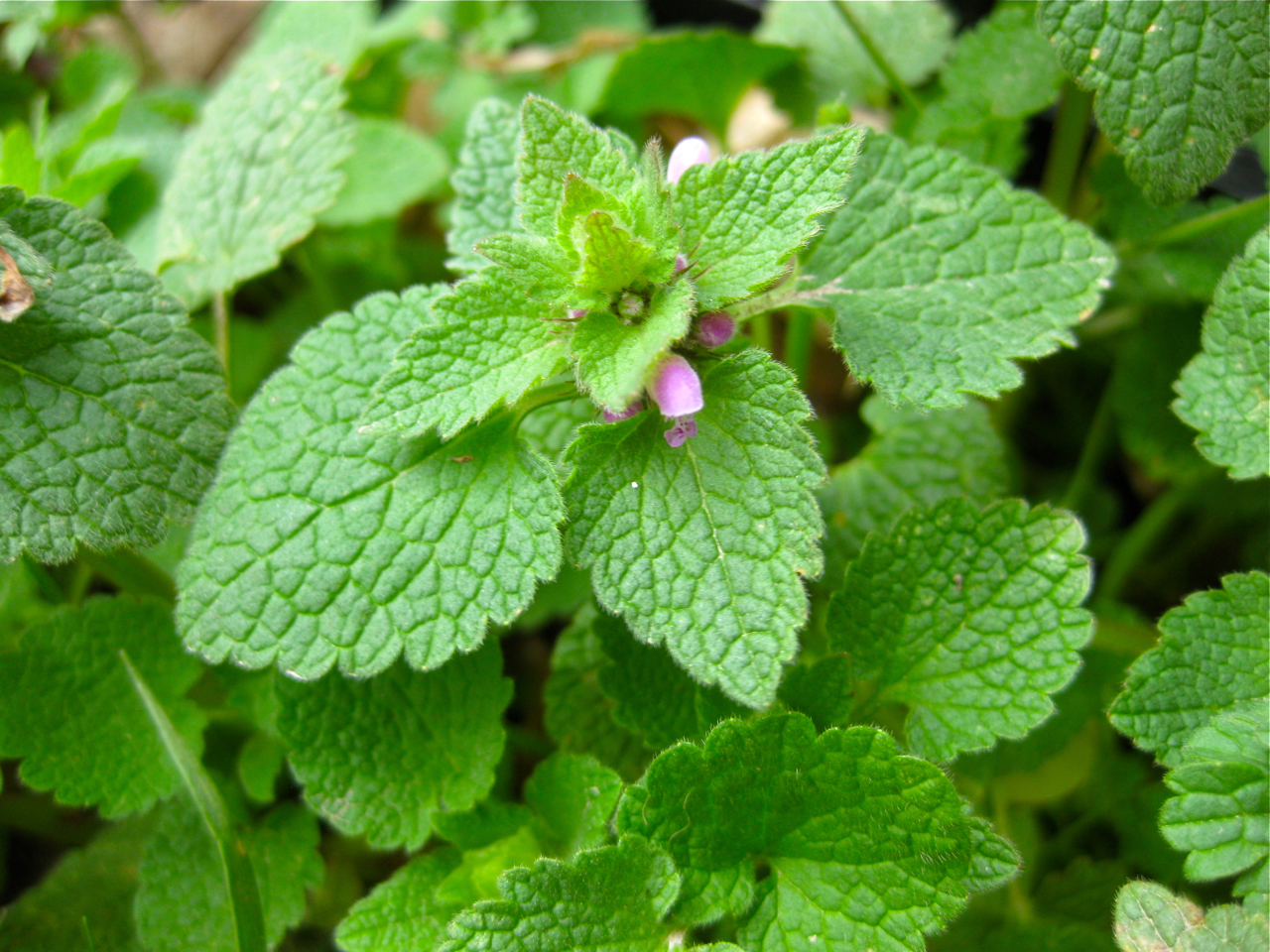Lawns…those ubiquitous constructions of man that have turned vast areas of the world into virtual green deserts and parking lots. A conservative estimate for lawns in the U.S. is 41 million acres, most of which are comprised of non native shallow rooted turf grasses that require constant mowing and provide little ecological benefit. Here in Oklahoma, the number one lawn grass is Bermuda grass. The irony of this is that Bermuda grass is one of the most invasive weeds we deal with on a day to day basis. Although it is a tough and drought tolerant plant, it’s ability to spread unchecked via rhizomes and stolons have made it a pervasive weed in the built landscape. We spend countless hours every year removing, containing, mowing and contending with this grass. Others have succinctly described the negative ecological impact of traditional lawns, but is there a way to reverse many of these negatives by simply choosing different turf grass species?
Researchers at the Ladybird Johnson Wildflower Center have delved into this question and come up with a blend of three native turf species that work together to create an adaptable, deep rooted, low-maintenance turf that can go a long way to making the lawn more ecologically beneficial. We, amongst others, have been using Buffalo Grass (Bouteloua dactyloides) as a Bermuda grass replacement and for the most part, we’re happy with the results. Using the Habiturf blend as a starting point we are exploring our own mixes of native turf and forb species to create an adaptable “Eco Lawn” for Oklahoma. In a following post, I’ll share some of our experiences with this process and give some how to advice. Here’s to a new turf paradigm!

Category: eco lawns
Natural Yards for Healthy Kids
Cool poster seen at Six Twelve.
Got Spring Weeds? Why Not Eat Them?
It’s springtime and as the soil and air temperatures begin to warm many opportunist plants get a jump on things and become “weeds” in disturbed places. Though they may seem to be a nuisance upon closer inspection they provide many benefits to wildlife and man. So before you get out your weed eater, garden gloves or, god forbid, your herbicide of choice, consider eating, appreciating and using these weeds. The following is a brief introduction to some of the more common spring weeds and their uses.
Henbit (Lamium amplexicaule)– This ubiquitous flowering spring weed is such a pan global migrant that it’s exact place of origin is not known. It is thought to have originated in the Mediterranean and it has long been naturalized in the U.S. Like many such weeds it thrives mainly in places of human disturbance so it’s not much of a threat to healthy native vegetation. As weeds go, this one provides many benefits, so it is worth considering it’s values. First to consider are the lovely blossoms which can paint a whole field bright magenta in Spring. I have even observed the color from a plane! Upon closer inspection the flower has a beautiful orchid like appearance. These lovely little flowers provide an early nectar and pollen source for bees and pollinators. Secondly the whole plant is edible! It can be eaten raw or cooked and has a somewhat mild flavor similar to many common greens (lettuce and kale come to mind). It can be good in salads, soups, wraps or even green smoothies. It has a ton of vitamins and as an anti-rheumatic herbal solution.
Dead Nettle (Lamium purpureum) – Dead Nettle is a very similar European relative of henbit. They can often be found growing together and they provide many of the same benefits. The best way to differentiate between the two is that Dead Nettle has more triangular shaped leaves and Henbit’s are more heart shaped. Dead Nettle also tends to have dark purple leaf coloration toward the top of the plant. Eat and prepare in the same way you would Henbit
Chickweed (stellaria media) – Another common lawn weed that tastes good and is good for you. It can be eaten raw and it has the texture of corn silk, it makes a great addition to salads, and when cooked it kind of tastes like spinach. Since chickweed is stringy it is often best to chop it up. Chickweed does contain small amounts of saponins so it is best eaten moderately.
Dandelion (Taraxacum officinale) – Another pan global opportunist, Dandelion is a staple of springtime and can be a staple of the everyday diet. Dandelion is another one that can be eaten raw or cooked. They are a little bitter so picking the smaller leaves can help make it a little more palatable. Blanching the leaves will also help reduce bitterness. Dandelion leaves can be wilted or steamed and the flowers are edible too. The flowers have a fairly sweet taste and crunchy texture which goes well in salads. They can be used to make dandelion wine as well. If that was not enough, the roots can be dug up and used as a substitute for coffee. The whole plant also has medicinal benefits, in particular known to detoxify the liver. In Europe, Dandelions are often grown as a garden green and numerous cultivars are available.
These are only a few of the many plants available for foraging so do some research and find out what plants are in the neighborhood. When picking and consuming edible weeds it is important to be very cautious because some plants look like others (do your research carefully!!). As a word of caution it is best to eat wild foods in moderation, especially when beginning. These plants have very concentrated nutrients compared to their cultivated counterparts so it can take a while for your body to adjust to eating them. If any area has been subjected to chemicals of any sort then it is best to avoid eating anything taken from that area. Happy hunting and Bon Appétit!!
Ps. If you’ve eaten your fill of edible weeds and still have too many, give us a call for some garden maintenance.
For more information on foraging Oklahoma edibles of all kinds visit:
Oklahoma Wildcrafting
more general information and good photos for ID can be found here:
Eat The Weeds
Safe and Natural Eco Lawn Care
It’s getting to be that time of year again when everyone seems to have a green lawn. It is not the lush green we associate with summer but rather the artificial green that only means one thing, a spray pre-emergent. Spraying lawn chemicals may seem to provide our lawns a leg up with spring fast approaching, however, we must be careful that we are not doing more harm than good. While lawn chemicals seem to primarily stay on the lawn this is not necessarily true. In a recent study by the Center for Disease Control 100% of the 9,282 of the people nationwide were found to have traces of lawn chemicals in either their blood or urine. The average person in the study had 13 of the 23 chemicals in their system. This is an outrageous concept, and most adults are less susceptible than children. Children are more often playing in the grass, putting their hands in their mouth, and even playing on the carpet (which can contain the chemicals tracked in from outside.) The vapors and chemicals can remain potent for a month or even a year! Not only are there harmful effects for humans but for our ecosystem that we are trying to beautify as well. The chemicals meant to kill pest or weeds may destroy nitrogen-fixing microorganisms that are helping to provide nutrients for our lawns. It may even kill earthworms or other insects that aerate the soil causing it to compact. Along with these effects there are many others. Of the 30 major chemicals used on lawns 23 are detected in groundwater, and runoff causes algal blooms which depletes oxygen levels in water causing lessened aquatic life. Ultimately we can be our lawn’s worst enemy and the effects can be far reaching beyond our capacity to comprehend. However, multiple solutions exist so we do not have to be stuck with this problem.
Our Eco Landsaping lawn treatments provide a chemical free solution that will keep your lawn green and your neighborhood safer. Our basic service utilizes corn gluten meal which acts as a gentle “weed and feed”. We apply this 4 times a year and usually this is enough to keep your lawn looking good. We have a range of other eco friendly services that can be used on an as-needed basis. There are also some maintenance cultural practices that we recommend that will help keep your lawn looking good. We’ll cover that in a future post. Give us a call so we can help you Go green in 2015!







